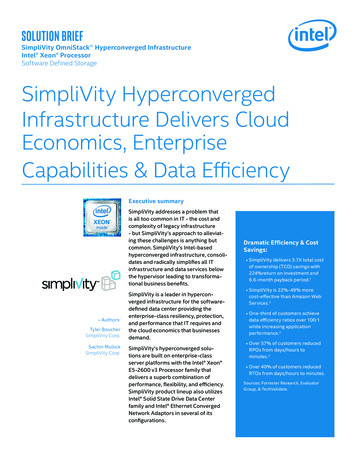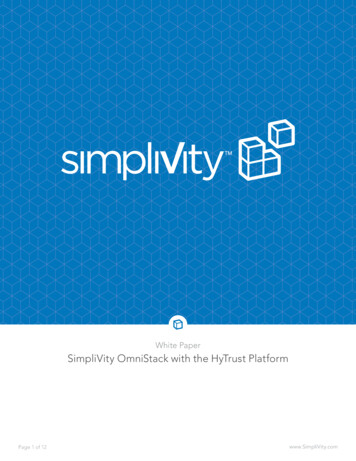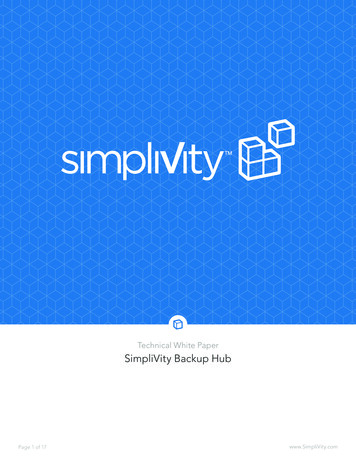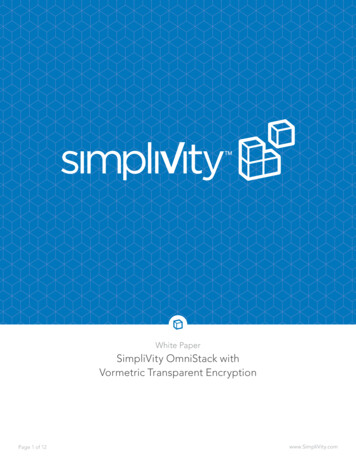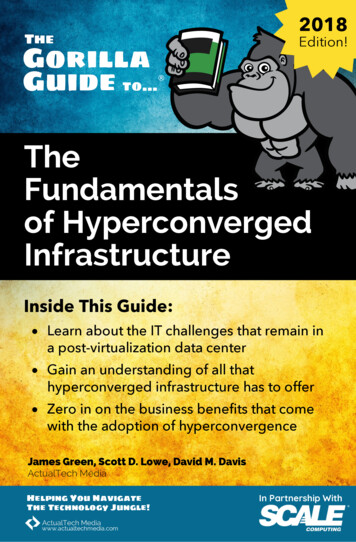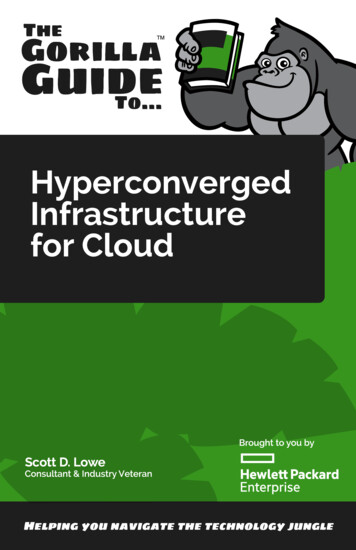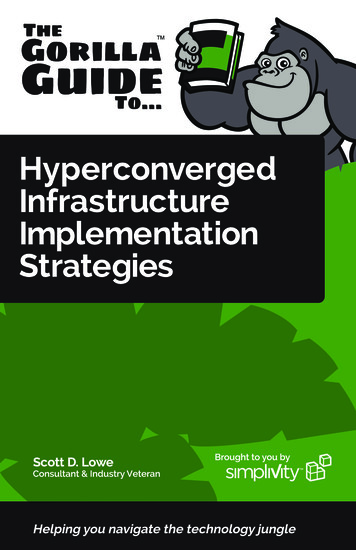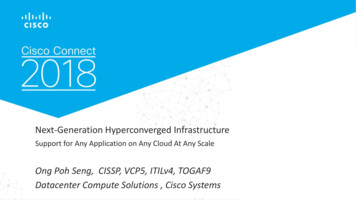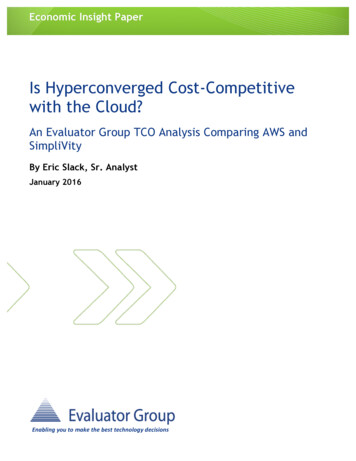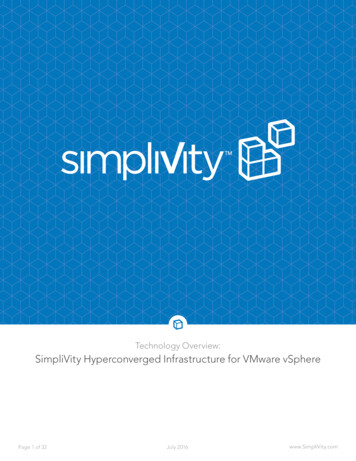
Transcription
Technology Overview:SimpliVity Hyperconverged Infrastructure for VMware vSpherePage 1 of 32July 2016www.SimpliVity.com
Technology OverviewTHE INFORMATION PRESENTED IN THIS PAPER IS SUBJECT TO CHANGE WITHOUT NOTICE.SimpliVity, the SimpliVity logo, OmniCube, OmniStack, and Data Virtualization Platform are trademarks or registeredtrademarks of SimpliVity Corporation in the United States and certain other countries. All other trademarks are theproperties of their respective owners.Page 2 of 32 SimpliVity Hyperconverged Infrastructure Technology Overviewwww.SimpliVity.com
Technology OverviewTable of Contents1. Introduction. 51.1. Purpose. 51.2. Audience. 52. Introduction to SimpliVity Hyperconverged Infrastructure. 52.1. Background. 52.2. The Data Problem. 62.3. Legacy IT Stack Limitations. 72.4. The Solution: SimpliVity Hyperconverged Infrastructure. 72.4.1. Accelerated Data Efficiency. 72.4.2. Global Unified Management. 82.4.3. Built-in Data Protection. 83. SimpliVity Technology Overview. 83.1. Terminology. 83.2. SimpliVity Scale-Out Architecture. 93.2.1. SimpliVity OmniStack Node. 93.2.2. SimpliVity Data Center. 113.2.3. SimpliVity Federation. 123.2.4. Supported Federation Topologies. 123.3. Data Virtualization Platform. 133.3.1. Presentation Layer. 133.3.2. Data Management Layer. 133.3.3. VM-Centric Design. 153.3.4. Inline Deduplication, Compression, and Optimization. 153.4. Resiliency and High Availability. 153.4.1. Node Availability. 153.4.2. Cluster Availability. 163.4.3. Federation Availability. 173.4.4. Highly-Efficient Data Backup, Replication, and Recover. 174. SimpliVity Management Capabilities and Interfaces. 194.1. Management Functions. 194.1.1. Data Protection and Recovery. 194.1.2. Troubleshooting and diagnostics. 20Page 3 of 32 SimpliVity Hyperconverged Infrastructure Technology Overviewwww.SimpliVity.com
Technology Overview4.2. Deployment and Upgrades. 214.2.1. Deployment. 214.2.2. Upgrades. 214.3. Plug-Ins for Native Hypervisor System Management Applications. 224.4. Plug-Ins for Third-Party Service Orchestration Applications. 254.5. Native Management Interfaces and APIs. 274.5.1. Command Line Interface. 274.5.2. Programmatic APIs. 284.6. OmniView. 285. SimpliVity Hyperconverged Infrastructure Benefits. 295.1. Enterprise Capabilities. 295.2. Cloud Economics. 296. SimpliVity Hyperconverged Infrastructure Use Cases. 307. Additional Information. 308. Index. 30Appendix: List of Abbreviations. 31Figure 1: Siloed IT architectures are inherently inefficient, cumbersome, and costly. 6Figure 2: SimpliVity OmniCube. 9Figure 3: The Components of an OmniStack Node. 10Figure 4: Data Virtualization Platform spanning three OmniStack nodes. 14Figure 5: Data Virtualization Platform spanning three Data Centers. 14Figure 6: High Availability Write Path. 16Figure 7: Simple restoration of an entire VM or specific files/folders. 18Figure 8: SimpliVity Alarms within the vSphere Web Client. 20Figure 9: vSphere Web Client integration. 22Figure 10: SimpliVity vCenter node view. 23Figure 11: SimpliVity vSphere Web Client capacity view. 24Figure 12: DRS Rule created by SimpliVity’s Intelligent Workload Optimizer. 25Figure 13: SimpliVity Data Protection example. 26Figure 14: SimpliVity integration with Cisco UCS Director. 26Figure 15: SimpliVity integration with VMware vRealize Automation. 27Figure 16: The OmniView dashboard. 28Page 4 of 32 SimpliVity Hyperconverged Infrastructure Technology Overviewwww.SimpliVity.com
Technology Overview1. Introduction1.1. PurposeThis Technology Overview reviews the features and benefits of SimpliVity hyperconverged infrastructure and describes thehardware and software components and subsystems that make up the solution.The document explains the functions and inner-workings of the solution. It decomposes the SimpliVity solution into physical and logical constructs and describes the various internal and external interfaces and data flows. Particular attentionis given to the inherent data efficiencies of the SimpliVity architecture as well as the VM-centric, unified managementapproach that simplifies system administration, data protection, and service automation.The document also reviews supported SimpliVity configurations and deployment models, and provides sample use casesfor SimpliVity hyperconverged infrastructure.1.2. AudienceThe Technology Overview is intended to assist IT planners, architects, system administrators, system integrators, andother technology professionals who are researching, evaluating or implementing SimpliVity hyperconverged infrastructuresolutions. It explains the key performance, scalability, availability and manageability aspects of the SimpliVity solution andprovides a brief overview of the basic system design, deployment and integration guidelines to assist with project planning and best practices development.2. Introduction to SimpliVity Hyperconverged Infrastructure2.1. BackgroundMany enterprises are hampered by legacy IT infrastructure that isn’t well suited for today’s cloud-based services and ondemand applications. These legacy IT architectures are composed of siloed compute, storage, network, and data protection platforms with distinct administrative interfaces. Each platform requires support, maintenance, licensing, power, andcooling—not to mention a set of dedicated team members capable of administrating and maintaining the system. Deploying a new application can be a manually-intensive, time-consuming proposition involving a number of different platforms,management interfaces, and operations teams. Turning up new IT services can take days or even weeks. Troubleshootingproblems and performing routine data backup, replication and recovery tasks can be just as inefficient.Page 5 of 32 SimpliVity Hyperconverged Infrastructure Technology Overviewwww.SimpliVity.com
Technology Overview2.2. The Data ProblemEnterprise data has historically grown exponentially, resulting in ever-increasing storage capacity needs. At the same time,businesses are placing pressure on IT to back up data more frequently, restore that data more quickly, and support moreaggressive SLAs. Unfortunately, performance of individual hard disk drives (HDDs) has not increased relative to the capacity increases, causing a major disconnect between storage capacity and storage performance. The solution to this problem has traditionally required either the utilization of solid state drives (SSDs) or the creation of oversized pools of HDDs inorder to provide the necessary performance, both of which increase the cost of the storage system.Enterprise IT organizations have invested in a variety of discrete data storage, data efficiency and data protection solutionsto cope with this ever-increasing data growth. Various point technologies were introduced over time—bolted on in a reactive manner to tackle a particular symptom of the data problem. As a result, many organizations are now held hostage to amultitude of disparate data storage, management and protection products. Each product is often supplied by a differentvendor and features a unique administrative interface and distinct APIs.A legacy IT stack might include:(4) Servers VMwareStorage Switch(2) HA Shared StorageBackup & DedupeWAN OptimizationCloud GatewaySSD ArrayStorage CachingData Protection ApplicationData Protection AppsData ProtectionApplicationFigure 1: Siloed IT architectures are inherently inefficient,cumbersome, and costly.Page 6 of 32 SimpliVity Hyperconverged Infrastructure Technology Overviewwww.SimpliVity.com
Technology Overview2.3. Legacy IT Stack LimitationsSiloed IT architectures can’t meet the stringent price-performance, scalability, and agility demands of today’s highly virtualized IT environments and data-intensive applications. Legacy IT stack disadvantages and constraints include: High CapEx – A variety of independent technology platforms to purchase and scale results in resources that areoften wasted, due to the chronic difficulty in scaling and integration of the individual platforms. This leads to regularoverbuying of capacity and repeat periods of underutilized IT assets. High OpEx – With so many independent technology platforms, IT operational expenses can be high, with multiplepoints of management, additional training requirements, hardware and software maintenance fees, power, cooling, andrack space for each silo. Inadequate data protection – Many IT organizations are challenged to meet backup and recovery goals with existingdata protection solutions. This is particularly true in smaller data centers or remote offices due to cost constraints. VMbackup and restore jobs can take hours or days when using legacy solutions that store and manage the different stagesof the data lifecycle in separate, independent silos. Inefficient resource utilization – Conventional data storage, optimization and protection solutions were designedaround physical servers and these storage systems aren’t well suited for virtualized IT. To ensure peak performancewithin each silo, these solutions overprovision storage resources and network bandwidth, causing customers to overbuyin every silo. Poor service agility – Turning up new applications and IT services can take weeks, due to the complexities of coordinating multiple technology platforms and points of administration. This impairs the organization’s service velocity andtime-to-market. High barriers to innovation – IT teams spend the bulk of their time provisioning, maintaining, extending and refreshingunderlying IT infrastructure instead of working on strategic business initiatives.2.4. The Solution: SimpliVity Hyperconverged InfrastructureSimpliVity hyperconverged infrastructure is designed from the ground up to meet the increased efficiency, managementand data protection demands of today’s data-intensive, highly-virtualized IT environments. The SimpliVity solution provides a scalable, modular, 2U building block of x86 resources that offers all the functionality of traditional IT infrastructure—in one device. It assimilates storage; compute; hypervisor; real-time deduplication, compression, and optimization;along with comprehensive data management, data protection, and disaster recovery capabilities.Designed to work with any hypervisor or industry-standard x86 server platform, the SimpliVity solution provides a single,shared resource pool across the entire IT stack, eliminating point products and inefficient siloed IT architectures. The solution is distinguished from other converged infrastructure solutions by three unique attributes: accelerated data efficiency,global unified management, and built-in data protection.2.4.1. Accelerated Data EfficiencySimpliVity hyperconverged infrastructure performs hardware-assisted inline deduplication, compression and optimization on all data at inception across all phases of the data lifecycle (primary, backup, WAN, archive, and in the cloud), acrossall tiers within a system (DRAM, Flash/SSD, and HDD), all handled with fine data granularity of just 4KB-8KB. By drivingefficiencies at the point of origin and by offloading processor-intensive data handling functions on to purpose-built dataacceleration hardware, the solution optimizes the use of system resources and minimizes I/O and network traffic, accelerating data clone, backup, restore and mobility operations.Page 7 of 32 SimpliVity Hyperconverged Infrastructure Technology Overviewwww.SimpliVity.com
Technology Overview2.4.2. Global Unified ManagementSimplifying the complexities and administrative overhead of managing multiple silos of IT infrastructure distributed acrossmultiple data centers was one of the intentions of the SimpliVity solution from the very beginning. Rather than managingindividual silos at
SimpliVity, the SimpliVity logo, OmniCube, OmniStack, and Data Virtualization Platform are trademarks or registered . both of which increase the cost of the storage system. Enterprise IT organizations have invested in a variety of discrete data storage, data efficiency and data protection solutions .
